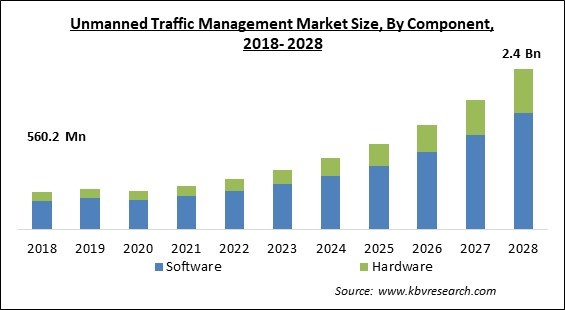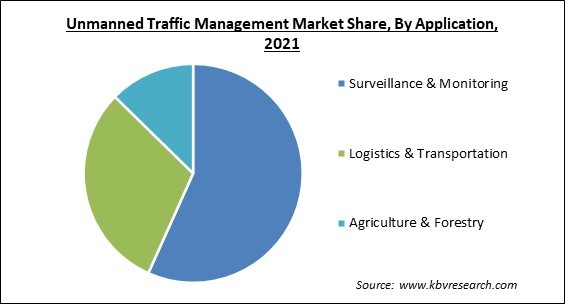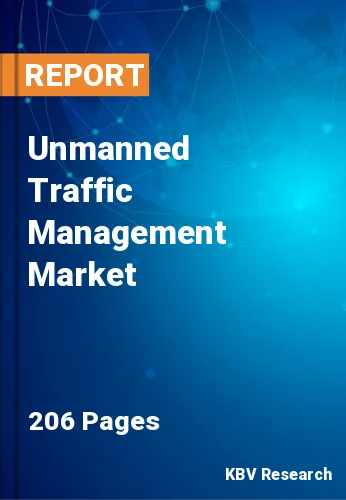The Global Unmanned Traffic Management Market size is expected to reach $2.4 billion by 2028, rising at a market growth of 21.1% CAGR during the forecast period.
Infrastructure monitoring, package delivery services, precision agriculture, photography, search and rescue operations, and other duties have long been studied for unmanned aircraft systems (UAS). Previously, UAS were mainly utilized for military reconnaissance and later for the controversial drone strike program of the United States military. The deployment of small unmanned aircraft systems (sUAS) for civilian purposes sparked controversy among lawmakers and federal regulatory organizations such as the Federal Aviation Administration (FAA). For early adopters of civilian drone technology, there existed a legal gray area because rules and regulations regulating the operation of these vehicles were practically nonexistent, notably at the federal and state levels. The FAA Modernization and Reform Act, which was passed in 2012, recognized the need to prioritize drone safety and efficiency as essential short-term goals.

The FAA, NASA, other federal partner agencies, and industry are working together to explore operational concepts, data exchange requirements, and a supporting framework to facilitate various beyond visual line-of-sight (BVLOS) drone operations at lower elevations (under 400 feet above ground level (AGL)) in airspace where FAA air traffic services are not available.
The FAA's Air Traffic Management (ATM) system is separate from, but complementary to, the Unmanned Aircraft System Traffic Management (UTM) ecosystem for uncontrolled operations. Services, roles and duties, information architecture, data exchange protocols, software functionalities, infrastructure, and performance requirements for managing low-altitude uncontrolled drone operations will all be identified as part of UTM development.
To record research objectives and map out the development of UTM, the FAA and NASA collaborated on a joint UTM Research Plan. NASA is undertaking research at UAS Test Sites to better investigate UTM capabilities that will allow for rulemaking as drone integration grows. UTM capabilities are expected to be introduced in stages over the next few years, according to the FAA.
The influence of COVID-19 on the autonomous traffic management business is uncertain, although it is expected to last a few years. The COVID-19 pandemic compelled governments around the world to impose strict quarantines and ban the import-export of raw materials for the majority of 2020 and a few months in 2021. As a result, the availability of critical components for manufacturing unmanned traffic management components dropped dramatically. Furthermore, the nationwide lockdown prompted unmanned traffic management manufacturing factories to shut down partially or fully. The COVID-19 outbreak has caused delays in actions and projects related to the development of advanced autonomous traffic management services all over the world.
Drones, or unmanned aircraft vehicles, are becoming more common in daily life and are rapidly expanding in a variety of ways. Drones are also utilized for a variety of objectives, including recreational, commercial, and other uses. Drones are used in agriculture to optimize fertilizer, seed, and water use, reduce crop scouting time, respond more quickly to pests, weeds, and fungi, validate treatment conducted, improve various treatments in real-time, and anticipate production from a field, to name a few examples. During the projected period, the unmanned traffic management market is expected to rise due to the increasing use of drones in various sectors and the development of improved drones.
Increasing governmental and private sector investments in the development of autonomous traffic management systems are expected to fuel market expansion over the forecast period. For example, Terra Drone Corporation raised a B-series fund of $70 million (8 billion Japanese yen) in March 2022 to speed the development of Unmanned Traffic Management, or UTM, an air traffic control system for unmanned aircraft. Furthermore, the expansion of the unmanned traffic management market is likely to be fueled by the development of unmanned traffic systems and partnerships between private and public market participants to improve the performance and efficiency of UTM.
Unmanned traffic management (UTM) differs from the air traffic control system used by the Federal Aviation Administration (FAA) for commercial airplanes, according to the National Aeronautical and Space Administration (NASA). UTM is based on each user's anticipated flight details being shared digitally. Unlike air traffic control, each user will have the same situational awareness of the airspace. In addition, UTM systems communicate real-time data with unmanned aerial vehicles (UAVs) or drone pilots to ensure that activities are run safely and efficiently. Such data is transferred through a distributed network of highly automated devices using application programming interfaces, with the exception of voice communication (API).
Based on Component, the market is segmented into Software and Hardware. The software segment acquired the largest revenue share in the unmanned traffic management market in 2021. This is because UTM software solutions are used by public safety, defense, and emergency response agencies to keep first responders, soldiers, and the general public safe.

Based on Application, the market is segmented into Surveillance & Monitoring, Logistics & Transportation, and Agriculture & Forestry. The logistics and transportation segment garnered a substantial revenue share in the unmanned traffic management market in 2021. The increase in the deployment of tiny unmanned aerial systems (below 25 kg in weight) by e-commerce and retail companies can be ascribed to the expansion of this segment.
Based on End User, the market is segmented into Drone Operators or Pilots, Emergency Service & Local Authorities, Airports, and Recreational Users. The drone operators or pilots segment acquired the largest revenue share in the unmanned traffic management market in 2021. Any legal or natural person who operates or intends to operate one or more UAS is referred to as a UAS Operator. This could be a large business or a single person.
| Report Attribute | Details |
|---|---|
| Market size value in 2021 | USD 662.6 Million |
| Market size forecast in 2028 | USD 2.4 Billion |
| Base Year | 2021 |
| Historical Period | 2018 to 2020 |
| Forecast Period | 2022 to 2028 |
| Revenue Growth Rate | CAGR of 21.1% from 2022 to 2028 |
| Number of Pages | 206 |
| Number of Tables | 350 |
| Report coverage | Market Trends, Revenue Estimation and Forecast, Segmentation Analysis, Regional and Country Breakdown, Companies Strategic Developments, Company Profiling |
| Segments covered | Component, Application, End User, Region |
| Country scope | US, Canada, Mexico, Germany, UK, France, Russia, Spain, Italy, China, Japan, India, South Korea, Australia, Singapore, Brazil, Argentina, UAE, Saudi Arabia, South Africa, Nigeria |
| Growth Drivers |
|
| Restraints |
|
Based on Regions, the market is segmented into North America, Europe, Asia Pacific, and Latin America, Middle East & Africa. North America acquired the highest revenue share in the unmanned traffic management market in 2021. This is due to an increase in drone activity, increased government spending on drone BVLOS operations, and the presence of significant firms in the region like AirMap, Lockheed Martin, and Harris Corporation. As the region is technologically advanced with a flourishing economy, it has been the flagbearer of drone adoption for various purposes.
Free Valuable Insights: Global Unmanned Traffic Management Market size to reach USD 2.4 Billion by 2028
The market research report covers the analysis of key stake holders of the market. Key companies profiled in the report include L3Harris Technologies, Inc., Airbus SE, Thales Group S.A., Leonardo SpA, Altitude Angel Limited, Droniq GmbH, OneSky Systems, Inc., PrecisionHawk, Inc., Terra Drone Corporation (Terra Motors Corporation), and Unifly NV.
By Component
By Application
By End User
By Geography
The unmanned traffic management market size is projected to reach USD 2.4 billion by 2028.
Encouraging Growth Rate of The Drone Market are driving the market in coming years, however, Threat to Privacy and Security of Individuals limited the growth of the market.
L3Harris Technologies, Inc., Airbus SE, Thales Group S.A., Leonardo SpA, Altitude Angel Limited, Droniq GmbH, OneSky Systems, Inc., PrecisionHawk, Inc., Terra Drone Corporation (Terra Motors Corporation), and Unifly NV.
The expected CAGR of the unmanned traffic management market is 21.1% from 2022 to 2028.
The Surveillance & Monitoring segment acquired maximum revenue share in the Global Unmanned Traffic Management Market by Application in 2021, thereby, achieving a market value of $1.35 billion by 2028.
The North America market dominated the Global Unmanned Traffic Management Market by Region in 2021, and would continue to be a dominant market till 2028; thereby, achieving a market value of $1.36 billion by 2028.
Our team of dedicated experts can provide you with attractive expansion opportunities for your business.

